
I have enough I.1, 2005. Light box. 52 x 156 x 18 cm. Edition of 3. |

I have enough I.2, 2005. Light box. 52 x 156 x 18 cm. Edition of 3. |

I have enough I.3, 2005. Light box. 52 x 156 x 18 cm. Edition of 3. |
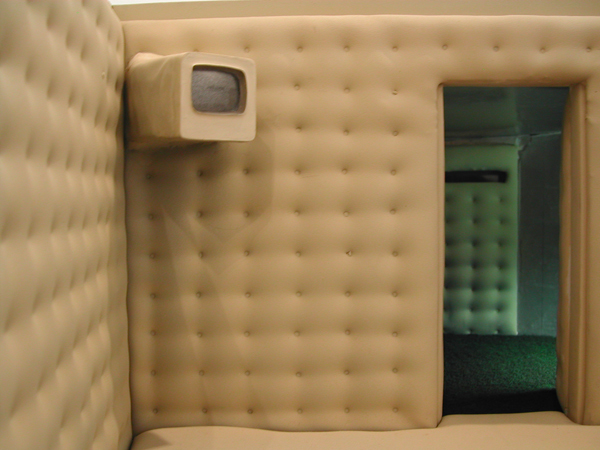
Models - Keller, 2007. Mockup. 39 x 65 x 110 cm. Unique edition. |
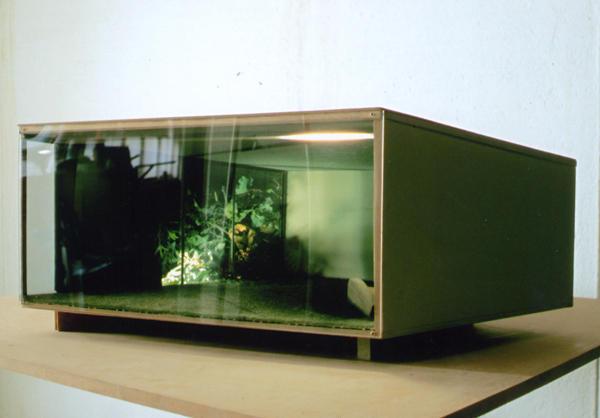
Models - Garden, 2006. Mockup. 37 x 98 x 93 cm. Unique edition. |

Miami, 2004. Colour photography. 39'8 x 120'5 cm. Edition of 7 + 2 artist's proofs. |
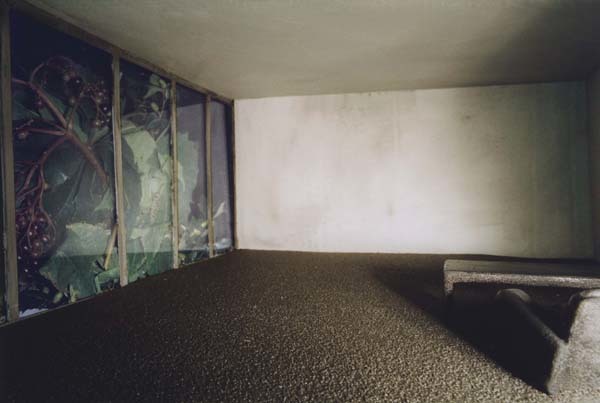
Garten 1, 2004. Colour photography. 50 x 74'2. Edition of 7 + 2 artist's proofs. |
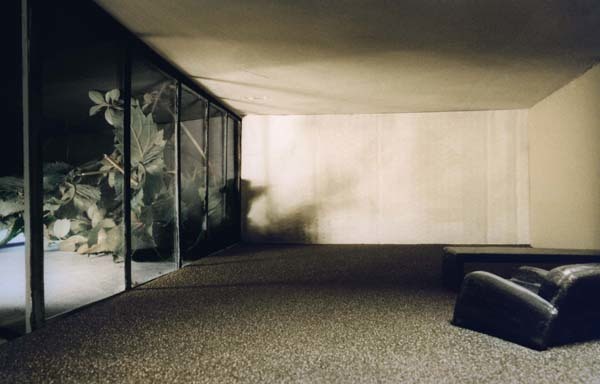
Garten 2, 2004. Colour photography. 50 x 74'2. Edition of 7 + 2 artist's proofs. |
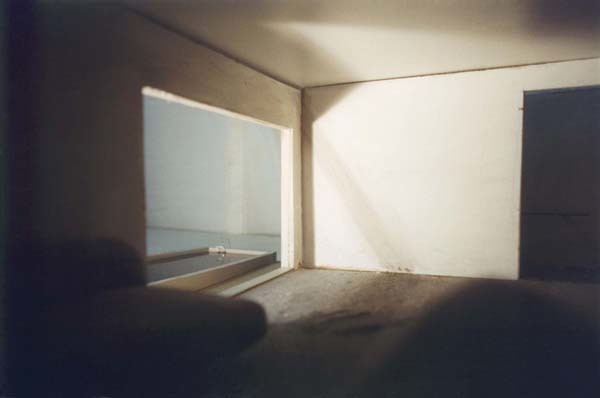
Pool, 2004. Colour photography. 50 x 75'2 cm. Edition of 7 + 2 artist's proofs. |
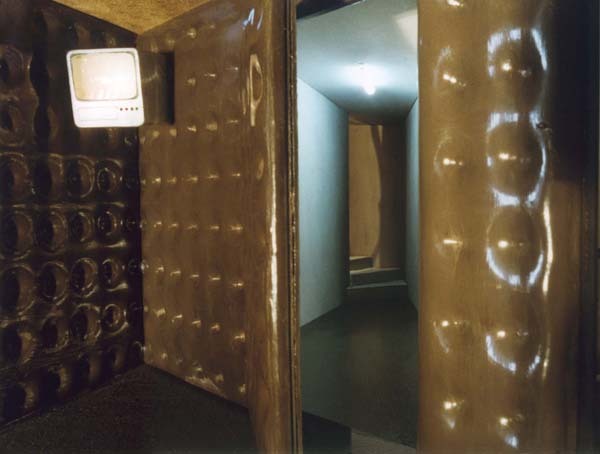
Keller, 2004. Colour photography. 50 x 60 cm. Edition of 7 + 2 artist's proofs. |
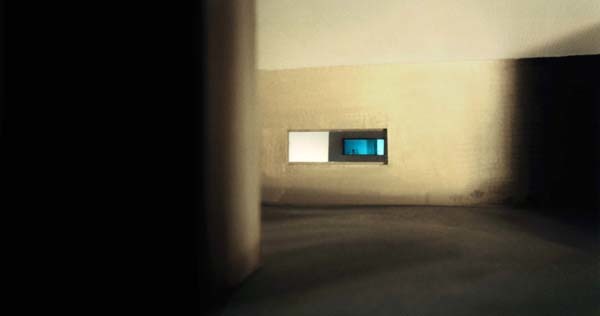
Manni, 2004. Colour photography. 39'8 x 75'7 cm. Edition of 7 + 2 artist's proofs. |
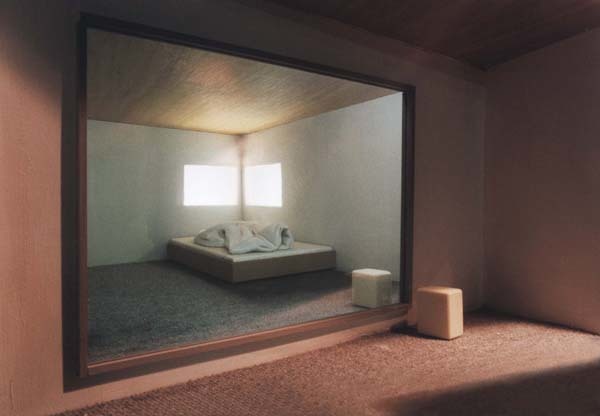
Spiegel, 2004. Colour photography. 50 x 72 cm. Edition of 7 + 2 artist's proofs. |
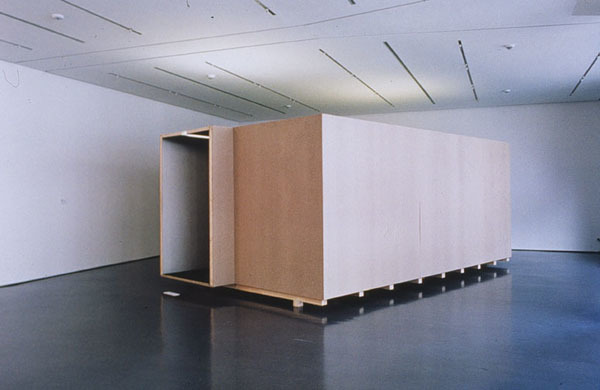
Flur - Casa, 2003. Installation and video. 8'. Unique edition. |
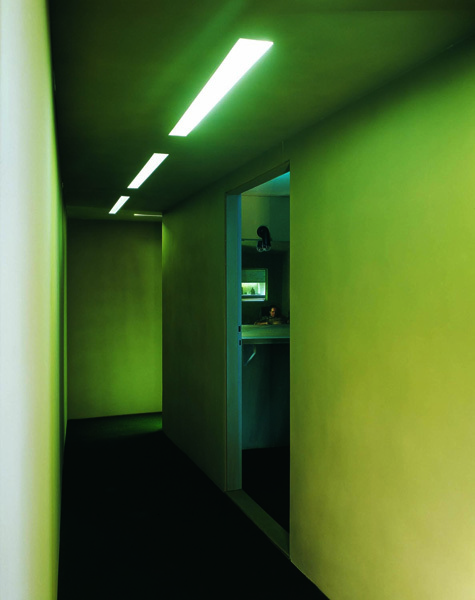
Flur - Casa, 2003. Installation and video. 8'. Unique edition. |
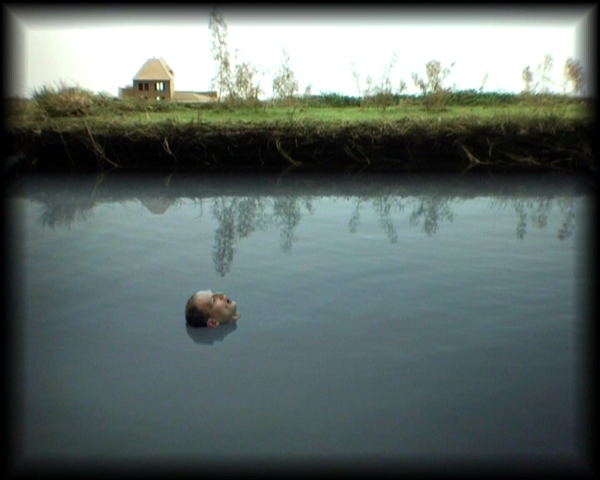
Ich habe genug - I have enough, 2005. Video. 14'. Edition of 5 + 2 artist's proofs. |
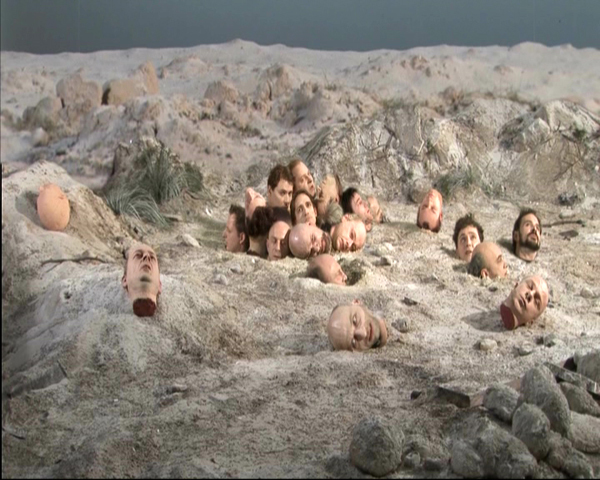
April, 2006. Video. 15'. Edition of 5 + 2 artist's proofs. |
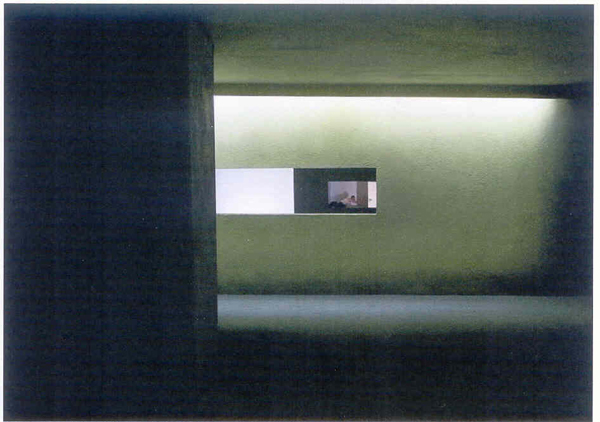
Neighbour, 2006. Light box. 50 x 70 cm. Edition of 4 + 2 artist's proofs. |
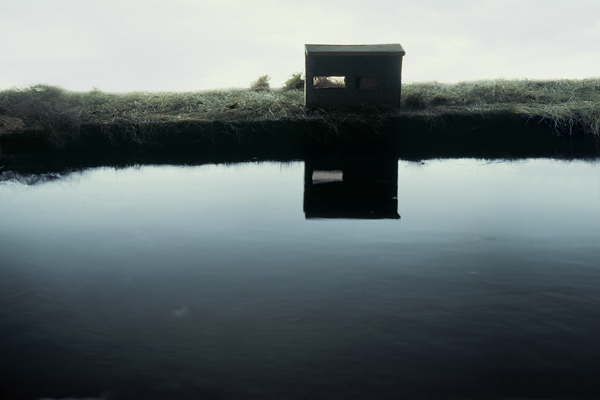
I have enough II.1, 2005. Light box. 41'7 x 61'7 x 8'5 cm. Edition of 5. |
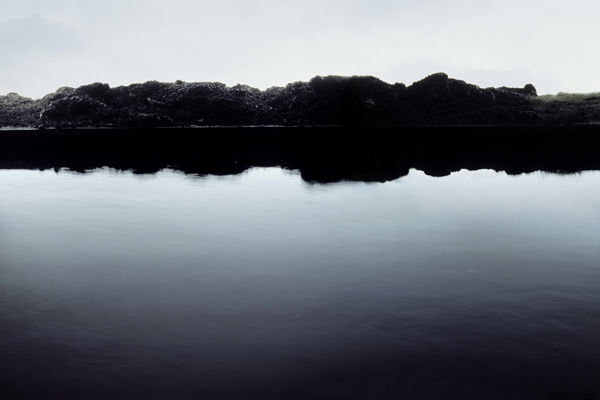
I have enough II.2, 2005. Light box. 41'7 x 61'7 x 8'5 cm. Edition of 5. |
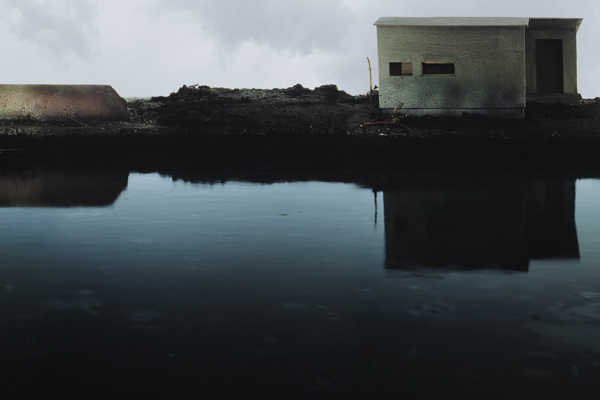
I have enough II.3, 2005. Light box. 41'7 x 61'7 x 8'5 cm. Edition of 5. |
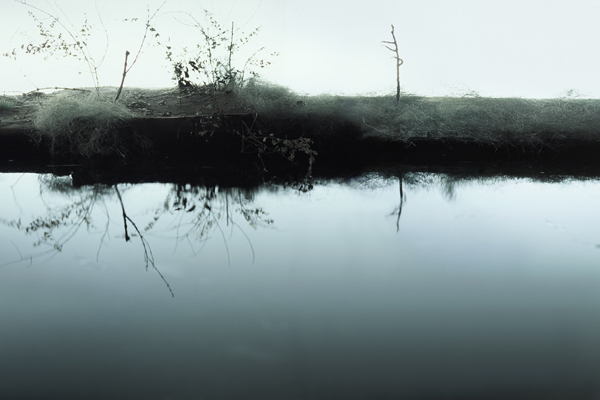
I have enough II.4, 2005. Light box. 41'7 x 61'7 x 8'5 cm. Edition of 5. |
In Alexandra Ranner’s video work "I have enough" we observe a head that has been severed from its torso. With great magnificence and a wistful voice, the head sings the Bach cantata "I have enough". A stylised landscape slowly passes by, the cloudy water carries along the head, that, in pain and ecstasy, gives expression to its wish to die.
Paradoxes dominate the unreal scenery: the bank flows along the stationary river, a decapitated head sings at the top of its voice, a dead person longs for his death, and baroque music as juxtaposition to today’s hedonistic world of consumption. These contradictory couplings present diverse references to the great tales in the history of civilisation.
The dramaturgy of the scenario is created by combining two contrasting basic motifs. One element stems from Orpheus’ mythology: Dyonisos demanded that Orpheus´ dismembered body was to be thrown into the Hebros, but his severed head keeps singing continuously, as it drifts along the river. With this he defies the power of both the Gods, and Death. The second element within the scenario is a Christian motif and is the Bach cantata “I have enough.” The singer desires death in simultaneous tender longing and ecstasy, as he wishes for redemption, as he has already internally bid farewell to the mundane world a long time ago.
The final voyage of the protagonist in the video "I have enough" is charged with moments of happiness and beauty. Such is the voyage of someone who has ridded himself of the larger part of his body and drifts in an intermediary state between life and death like a traveller through the world. The morbid beauty of the world is accented by his emphatic denial of the mundane world when he sings: "World, I will not remain here any longer; I own no part of you that could matter to my soul".
In his incompleteness he is more a part of the world than ever. The solemnity of the farewell, the defiance of deadly fear, and the desire for devotion and redemption come together in one single image. The protagonist passes by the world that he simultaneously loves and hates, and becomes more and more a part of it during this last voyage.
In her models and photographs Alexandra Ranner simulates and stages interiors in the form of three-dimensional, peepshow-like models and in the accompanying photographs, which are then used as the basis for further models. Sparse furnishing, suggestive lighting, subdued colors, and sequences of rooms and angles that leave many things unclear create an eerie, film-like atmosphere which stimulates voyeuristic fantasies at the same time as maintaining distance. The viewer is confronted with uneasy states of suspension, spatial situations that make no secret of their artifice but which nonetheless confound accustomed modes of perception, feeling both familiar and threatening, in a zone between public and private, between trendy minimalist chic and the breakdown of modernist architectural utopias.
In the big installation we found in the middle of the gallery, we see a narrow hall which gets narrower to the back and then leads round a corner. A half opened door offers a view into a room leading off from the hallway. We have to stop and think for a while what we are actually looking at. And even when we have realised what we are perceiving, we are none the wiser. The room is dimly lit. We can see a man sitting on a chair under a window and looking into a mirror, thus facing the observer and also able to watch what is going on in the house opposite. The scenario is unclear and full of foreboding: the man is sitting in semi-darkness in a claustrophobically small room and watching what is going in the neighbour’s home. The scene there is also unusual. The neighbour is dancing with a soft doll, throwing it around d and dancing with it again. We can only recognise this roughly, bur clearly enough to see that the mood is not exactly harmless.
The core piece of this work, the view into the room, is basically an illusion. At least events are not happening in the reality which she appears to present. Also, we can only see the scenario as a reflection, i.e. reversed. The mirror is a simple trick to enable people to make secret, unnoticed observations. The viewer looking at this work plays the double role: on the one hand he becomes a voyeur and to the other can be the object of voyeurism. “Flur” plays with our perception and also with reality: because the perceived depth of the room is only apparently real. It is real because it is visible, but the visible comes from a video projection playing on a wall opposite the mirror. And the projection is of a real situation recorded previously. In reality, what we see in front ourselves and perceive as the depth of the room, is actually happening behind our backs. The fascination of the work is in the fact that is makes our perception reality waver and even renders it obsolete.
On the plasma monitor we can see a vast field under the open sky, a landscape changing between piles of rubble and dunes. In the midst of it and pretending to be a natural course of action lies a heap of human heads. It’s the videoloop “April”. Like in the film “I have enough”, those heads are not dead. Having disposed of their bodies, they are in different states of being. The only evils which happen are because the heads are inevitably at each others mercy and inert. The main action in the film is based on the surroundings of the heads. The weather changes rapidly, strong winds blow over the heads, it is going to rain and just as quickly it turns hot and humid. The heads just lie, only their faces move. Depending on the mood of the group, they react with specific mimic: eyes glare, nostrils blow up (if they get excited) eyebrows, cheeks and chins flatter. They talk, from time to time serious arguments break out (loud screaming or hysterical accusations, insulted silence follows) as different characters are thrown together. The focus lies on each individual character and at the same time (through the construction of the pile and through the perspective of the camera) equally on the entire obscure scenario.
The atmosphere is carried by a continuous ludicrous and oppressive drama construed through a well composed mixture of noises, words and actions in context with the scurrile picture. The content of the spoken words and the simultaneously heard noises or background pictures should intertwine, partly counterpoint wise to give a broad range of emotional states.
YA TENGO BASTANTE BWV. 82
(Ich habe genug)
Música de Juan Sebastián Bach (1685 - 1750)
|
1. Arie (Alt) Ich habe genug, Ich habe den Heiland, das Hoffen der Frommen, Auf meine begierigen Arme genommen; Ich habe genug!
Ich hab' ihn erblickt, Mein Glaube hat Jesum ans Herze gedrückt; Nun wünsch' ich, noch heute mit Freuden Von hinnen zu scheiden. Ich habe genug!
2. Rezitativ (Alt) Ich habe genug! Mein Trost ist nur allein, Daß Jesus mein und ich sein eigen möchte sein. Im Glauben halt ich ihn, Da seh' ich auch mit Simeon, Die Freude jenes Lebens schon. Laßt uns mit diesem Manne ziehn! Ach! möchte mich von meines Leibes Ketten Der Herr erretten! Ach! wäre doch mein Abschied hier, Mit Freuden sagt' ich, Welt, zu dir: Ich habe genug!
3. Arie (Alt) Schlummert ein, ihr matten Augen, Fallet sanft und selig zu! Welt, ich bleibe nicht mehr hier, Hab' ich doch kein Teil an dir, Das der Seele könnte taugen. Hier muß ich das Elend bauen, Aber dort, dort werd' ich schauen Süßen Friede, stille Ruh'.
4. Rezitativ (Alt) Mein Gott! wenn kommt das schöne: Nun! Da ich im Friede fahren werde Und in dem Sande kühler Erde Und dort bei dir im Schoße ruhn? Der Abschied ist gemacht, Welt, gute Nacht!
5. Arie (Alt) Ich freue mich auf meinen Tod, Ach! hätt' er sich schon eingefunden. Da entkomm' ich aller Not, Die mich noch auf der Welt gebunden.
|

